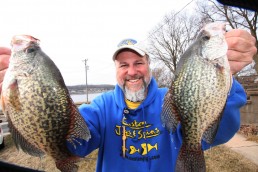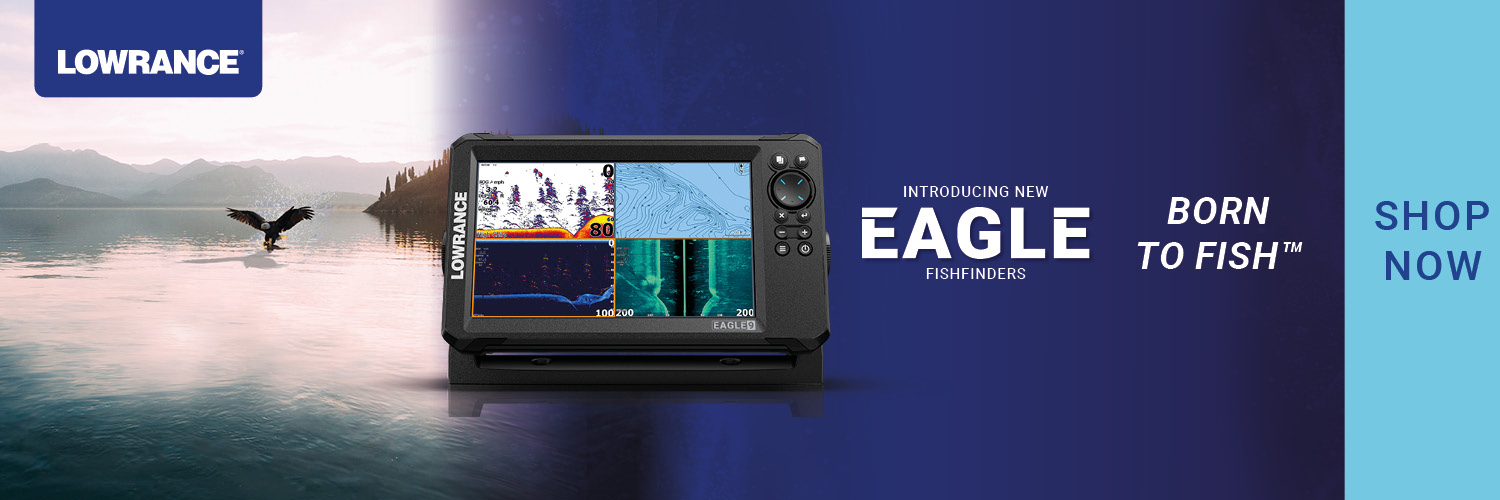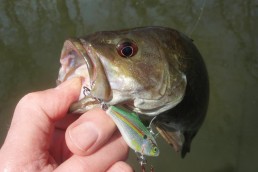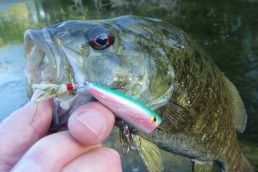Hair and Feathers Make for Great Fishing!
SHARE THIS POST
You wanna catch some fish? Use a jig. You wanna catch even more? Start with a jig that has hair or feathers attached.
Hair jigs have been around for millions of years. Early Neanderthal man made hair jigs from small rocks attached to the ear bone of the woolly mammoth (which was hook-shaped). They used the hair of a dog to catch zalleyes, which had the appearance of modern walleyes, but averaged 60 pounds!
April Fools in October! While none of this is true, chances are you once caught a bunch of fish on hair or feathered jigs, and sadly have left them to rust in your tackle box. Well it’s time to try them again; they are all the rage…like yoga pants!
Getting to know the hair jig
A hair jig is basically dyed bucktail hairs tied to a painted jig. The ones I prefer are Bucktail Wayne’s Jigs made for B-Fish-N Tackle. “Bucktail” Wayne Auchstetter, a longtime Mississippi River walleye guide, fishes these jigs for walleyes and sauger in the cold-water periods of spring and fall, all up and down the Mississippi River.
These jigs can be tipped with minnows or plastic or just fished “as is.” I like to have a few poles rigged, one for live bait and one with B-Fish-N’s Ribb-Finn plastic. The Ribb-Finn has a thin fork tail that’s constantly in motion, and a large ringworm body which creates bubbles and attracts fish to strike.
In rivers, I will switch back and forth between the two, by either vertical jigging while slipping downstream, or casting up shallow and working the jigs back to the river channel. The best casts are where there is a little current that pulls your jig downstream, and your jig ticks bottom along the way as the current pulls your jig back to the boat. It is best to jig it a few times under the boat before pulling it back up and making another cast. A lot of times, fish will hit it on that change of motion.
I find that two retrieves work best: dragging and snapping.
In dragging, you cast out and let the jig sink until your line goes slack. Reel in the slack, and then drag the jig along by lifting your rod, from straight out in front of you until it is straight up. Then drop it back down and reel in the slack. If a fish taps…reel in the slack and set the hook hard!
Snapping involves a slow, steady reel in with a one- to two-foot snap of your rod every three or four cranks or the reel handle. Obviously, there are about a million other variations of retrieves that you could try, but these two have worked for me.
Hair jigs are also great for largemouth and smallmouth bass fishing, especially in fall when the water turns cooler. You can still use the Ribb-Finn rigged to the bucktail jig. Crawling this jig along bottom is very productive. For smallmouth during fall, focus on steep shorelines. For largemouth bass, fish around shallow cover.
What can a feathered jig do for you?
Are you enjoying this post?
You can be among the first to get the latest info on where to go, what to use and how to use it!
Why, catch fish of course…
My best success with feathered jigs has been with the Flu-Flu series of jigs from Custom Jigs & Spins. These jigs have heavy heads, top-quality feathers and some great paint finishes.
The reason I like these jigs is because they catch the heck out of crappies. Crappies are very persnickety feeders, meaning they are light biters. Sometimes they swoop right in and grab the Flu-Flu; other times they bite lightly. For this reason, we use a very sensitive float, a Thill Shy Bite float.
The beauty of this float is that the slightest pull from a fish will make it totally disappear. More importantly, you can detect a “lift bite.” With the heavy head of the Flu-Flu combined with the sensitivity of the Thill Shy bite, you have a one-two punch for crappies. We’ll tip these jigs with one or two wax worms or a small minnow.
In fall, crappies are often located around wood cover; wood piers, wooden fish cribs and fallen trees. These are key areas to focus on when crappies are shallow in fall, before ice-up. Another great spot is a shallow bay attached to a channel; green weeds in this area will attract the crappie. Toss the float/Flu-Flu combination around and up to the cover, and twitch your rod tip every once in awhile to attract the fish nearby.
When the water is cold, hair and feather jigs really shine. Try some right now, and you’ll improve your catch rate for all species! MWO
Walt Matan has been a writer and television host for MidWest Outdoors for 30 years. An avid ice and open-water fisherman, he currently lives in the Quad Cities on the shores of the Mississippi River. He is the product developer and brand manager for Custom Jigs & Spins, B-Fish-N Tackle, and Rippin Lips Catfish Tackle. For more information visit customjigs.com.
For more information…
For more information on these jigs, log on to customjigs.com or bfishntackle.com, or call 1-800-831-5535 for a free Tips and Tricks catalog.
A nice pair of fall crappies.
MWO
SHARE THIS POST
Did you enjoy this post?
You can be among the first to get the latest info on where to go, what to use and how to use it!
Walt Matan
Walt Matan has been a writer and television host for MidWest Outdoors for 30 years. An avid ice and open-water fisherman, he currently lives in the Quad Cities on the shores of the Mississippi River. He is the product developer and brand manager for Custom Jigs & Spins, B-Fish-N Tackle, and Rippin Lips Catfish Tackle. For more information visit customjigs.com.




